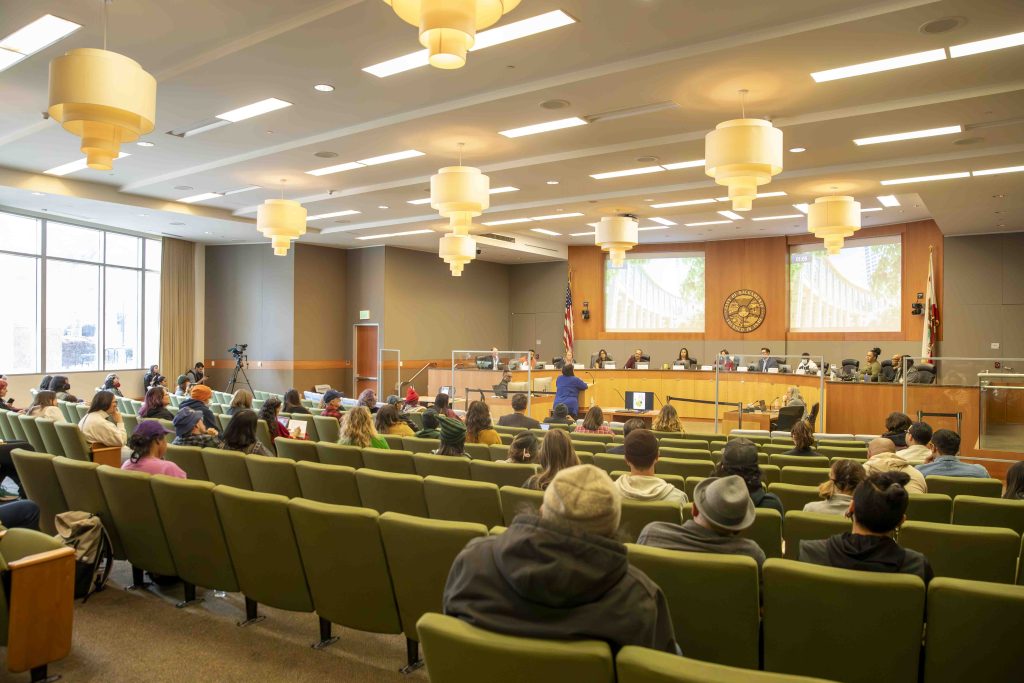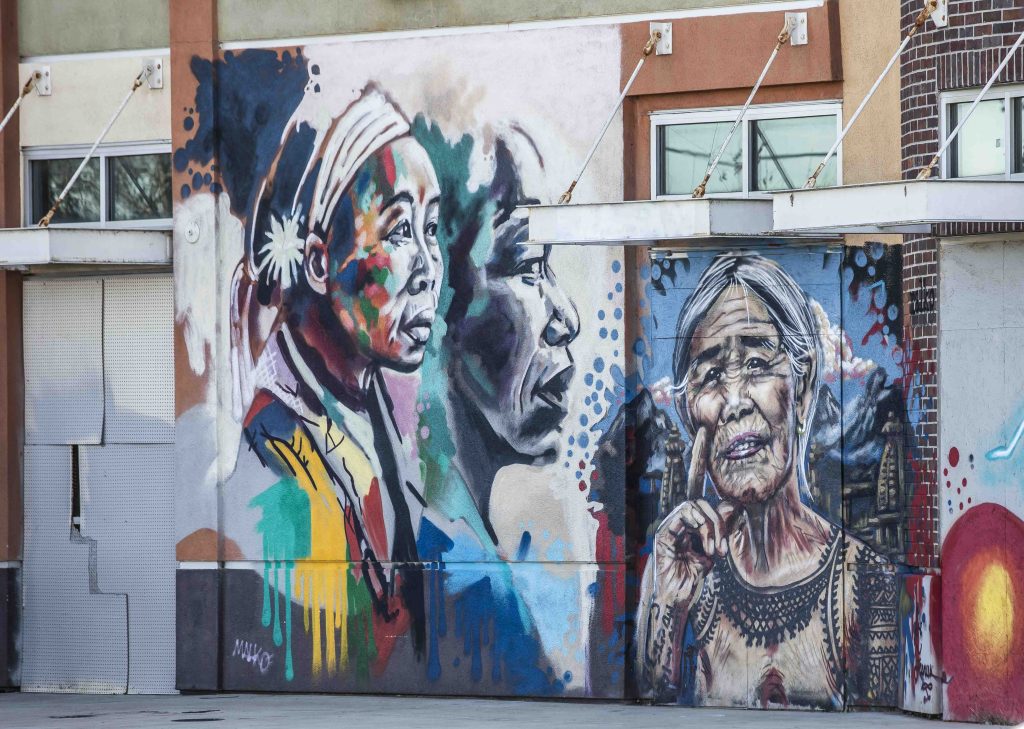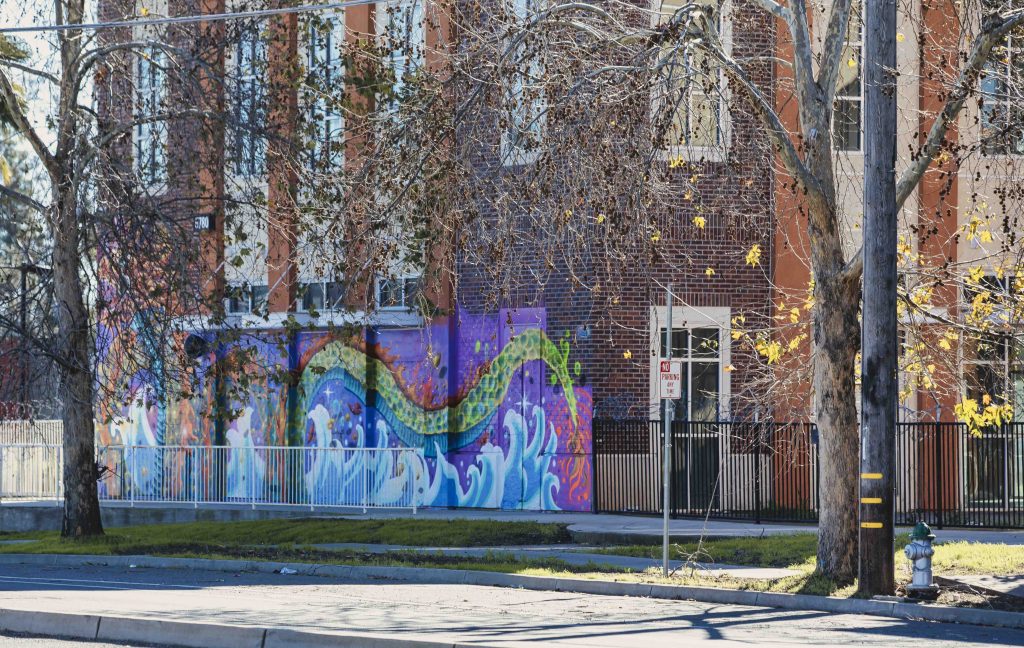Community members rally against ‘superficial stereotypes’ in mural project
By Hannah Ross
Wide Open Walls is finally having its day of reckoning, according to many in Sacramento’s arts community.
The nonprofit organization responsible for the annual 10-day-long summer arts festival and over 600 public art installations across the region is facing pushback from community members after announcing the unveiling of its newest murals on the WellSpace Health building in Little Saigon.
In anticipation of a public unveiling originally scheduled for Feb. 10, Wide Open Walls shared photos of the 500-foot public art installation “celebrating both Tết and Lunar New Year” as five “unique interpretations of the Year of the Dragon,” on its Instagram, inviting the community to celebrate with them.
But it didn’t take long for a glaring omission to be noticed. And the comments came flooding in.
“Is there a reason why there are no Asian artists or anyone from cultures that actually celebrate Tết or Lunar New Year?” Jamie Pesquiza Cardenas, a Filipinx film and fiber artist wrote on Instagram. “This was made in the middle of Little Saigon. Not even Viet artists were asked?”
Of the five artists selected by Wide Open Walls, none identify as Asian, Asian American or Pacific Islander (AAPI) — communities that historically observe Tết or Lunar New Year.
As over 400 comments surged under the social media post questioning the selection process, cultural accuracy, content of the murals and the overall ethos of the organization, Wide Open Walls and WellSpace Health canceled the event due to claims of weather impacting the artists’ ability to finish their work. (Wide Open Walls and WellSpace Health did not return requests for comment.)
Despite the palpable frustration surrounding the project, some say this experience — insulting to many in both the local arts scene and in the AAPI community — can serve as a lesson for how to do culturally significant projects, while keeping the bearers of that culture as the authoritative voice.
Key critiques

Artists and community members from Little Saigon — a stretch incorporating parts of Stockton Boulevard in South Sacramento — and the greater Sacramento region voiced their concerns about the authority of artists to depict cultures they do not seemingly belong to, and the impact of their representation in a community they do not appear to inhabit.
One of the murals, which has since been repainted, originally depicted a Kalinga warrior with inaccurate cultural markings as a representation of the Philippines indigenous ethnic group, the Kalinga people, according to the many comments on Wide Open Walls’ Instagram. Cardenas described the work as a caricature in their public comment at the City of Sacramento Arts, Culture and Creative Economy Commission’s monthly meeting at City Hall on Feb. 12, adding, “Kalinga people don’t even celebrate Lunar New Year.”
“They were wrong in not just the selection but the representation [in the art],” said Shawntay Gorman, a Black and Filipina artist, activist and arts educator. “As an artist, for you to be a storyteller and not do your proper research, or bring someone on as even just like someone on the mural team, is a disservice to the [art] community. Not just BIPOC and AAPI communities, it’s a disservice to us all.”
Diana Huynh, a first-generation Vietnamese American whose family owns a business in Little Saigon, said during public comment that she felt that the misrepresentation of Tết Nguyên Đán, the annual celebration of the arrival of spring based on the Vietnamese calendar, undermined the significance of the holiday and its tradition. Huynh felt that the images chosen reduced their culture to “superficial stereotypes.”
“Murals, by nature, live and take space in our communities, and therefore murals are for the people, especially when they’re charged with the responsibility of cultural representation and celebration of marginalized groups,” said Franceska Gamez, a Filipina muralist who has been making public art in Sacramento for 10 years. “But when murals are made through a quantity-over-quality formula that seeks to check DEI boxes without due diligence and community collaboration, they are performative, exploitive and used as a tool for gentrification.”
Sacramento City Councilmember Mai Vang wrote in a statement on Instagram,“It’s imperative not only to involve Asian American and Pacific Islander (AAPI) residents and artists in South Sacramento in the creative process, but to ensure they are leading it. I share my disappointment in Wide Open Walls’ (WOW) recent project in Sacramento’s Little Saigon and encourage them to listen and learn directly from the communities they have harmed and take the necessary steps to begin the healing process.”
‘Just another incident in the pattern’

At the Arts, Culture and Creative Economy Commission’s meeting, about 60 people filled the conference room at City Hall to participate in the session’s open comment, taking the opportunity to air grievances against Wide Open Walls’ lack of transparency, outreach and community engagement.
Many saw this incident as the final straw in what they consider Wide Open Walls’ monopolization of the public art sphere in Sacramento.
“This is not the only incident,” Sacramento’s Poet Laureate Andru Defeye said during his comment. “I know city officials, business owners and even some of you that have been told similar. These are not isolated incidents of racism, exclusion, co-opting and appropriation. It’s a pattern of harm, y’all. We won’t even get into how much their board makes versus how much the artists make, and how much of the financial ecosystem was ruined for muralists by an auctioneer and his buddies who have never sprayed a drop of paint on a wall. Wide Open Walls is the definition of cultural theft and exploitation of artists and needs to be viewed and treated that way.”
Jaya King and Rachel Kerns, both local muralists who have worked with Wide Open Walls before, were upset by the parallels across testimonies shared at public comment. “The general public has no idea and is really invested in and loves WOW,” Kerns said.
Gorman also spoke in an interview about holding Wide Open Walls accountable for its treatment of artists. “It’s all systematic. Wide Open Walls has monopolized the Sacramento art culture,” Gorman said, “If you speak out against them, they blacklist you, they blackball you, they talk bad about you. … It’s very difficult to try to rally people together to fight this issue.”
Wide Open Walls CEO and Board Chair David Sobon served on the Sacramento Metropolitan Arts Commission when the citywide mural festival was conceptualized in 2016. Sobon took over the concept as Wide Open Walls when, according to former art commissioner for Sacramento Metropolitan Arts Commission Maya Wallace, via a post on LinkedIn, “it wasn’t feasible for the city to manage a mural festival at that time.”
Originally, Sobon applied for funding from the City of Sacramento through David Sabon Events Inc. (DSE), until Wide Open Walls took on nonprofit status in 2018.
In 2022, The Office of the City Auditor for the City of Sacramento was unable to complete an audit of DSE and WOW because of commingling of funds between the two organizations, and funds awarded without written agreements of who the money was for and how it should be spent.
“Obviously, the concept of Wide Open Walls is great. I think that’s why they’ve got so far with what they’ve been doing,” said Jolene Rose Russell, a muralist and large-scale artist who participated in Wide Open Walls in 2021 and 2022. “I wish that there was more transparency with their finances. … We want to know where that money’s going.”
Wide Open Walls responded to comments on its Instagram post with a statement reaffirming their mission of “fostering inclusivity and representation.” They stated that, “For this project, we issued a call for participants that included API artists … We actively sought guidance from members of the API community to ensure that our selection process was enriched by diverse perspectives and cultural insights.”
Various artists and community organizers interviewed for this story, including Gorman; Nikki Abeleda, co-founder of Sacramento Filipinx LGBTQIA; and Megan Sapigao, director of special projects at Everyday Impact Consulting who is currently commissioning Filipino artists for an ad campaign for a Filipino ethnic media collaborative, said they did not see the open call from Wide Open Walls and could not name anyone who had.
Wide Open Walls stated on its Instagram that, “It’s essential to note that the final selection of artists was determined by various factors, including project requirements and artist availability,” and in response to the outpouring of public comment promised to host a community forum to, “provide a platform for open dialogue and collaboration, allowing us to better partner with our neighborhood and cultural representatives to create meaningful and inclusive experiences for all.”
In a virtual public comment made during the city arts commission meeting that has since been deleted, a commenter who used the name David Sobon wrote, “We do not currently have a set date for a completion of the mural. From the beginning, we have welcomed neighborhood feedback and continue to do so now. Some of the art was inspired by people who approached the artists. Other images, such as the warrior, were removed in response to the feedback. We look forward to unveiling the mural when its completed and having a conversation about what it represents.”
The comment was signed off with “Wide Open Walls.”
Agenda-ized

Monday’s arts commission meeting was resolved with a motion by Megan Van Voorhis, director of the city’s Convention and Cultural Services, to place Wide Open Walls as an agenda item at next month’s arts commission meeting to boost transparency with community members and gain insight from local artists.
“I’m so proud of my community to say enough is enough,” said Sapigao, of Everyday Impact Consulting, during public comment. “I’m sorry it took this long. I’m sad that our community can be a catalyst for this, but I’m behind this community of artists and folks who have been wronged and harmed. … It’s not lost on me that this happened to the Asian community, who’s often pegged as the model minority. It’s methodical to think we wouldn’t speak up.”
Some of the attendees viewed the meeting as a step in the process to remedy past harm, and an opportunity for arts groups to learn how to act on promises of inclusivity moving forward.
“Today was the first time I’ve really witnessed collective public testimony on any given issue,” said Cruz Naranjo, District 4 arts commissioner since 2019. “Today are the days that we live for, because we thrive on public engagement, it’s our purpose and mission in even existing. Today, fulfills our mission that much more so we can address concerns of issues in the community that we would otherwise not know.”
Sapigao added that van Voorhis’s step to include Wide Open Walls on the commission’s next agenda is an important part of holding the commission to its promise of supporting a diverse creative ecosystem in Sacramento.
“The commission is an ally in this,” Sapigao added, expressing excitement for next month’s meeting, set for March 11, for the opportunity to collectively conceptualize a more equitable creative future. “Let’s change this culture and turn it on its head and do something different.”
“At the end of the day, what are boards and commissions for if not to hold some power?” Sapigao said, adding that there is still more work to be done to ensure equitable and inclusive spaces, and that they hoped the Wide Open Walls project would serve as an example for other sectors to be intentional in their DEI work.
Sapigao suggested the need to start an organization similar to Wide Open Walls, but with different leadership more directly rooted in community arts initiatives as potential direct actions she would like to see.
“If we move on from Wide Open Walls, I think that would just open so much more opportunity for local artists in Sacramento,” Gorman said. “A lot of the murals that Wide Open Walls has sponsored are from artists outside of Sacramento. You know, there’s so much talent in Sacramento. For us not to represent our own city is crazy.”
Many artists interviewed agreed that relationship-building is central to figuring out a better path forward. Abeleda, community organizer for Sacramento Filipinx LGBTQIA, noted that “Artists or organizations that want to do work in a very diverse community need to build relationships with the communities and neighbors and people who live there … and give opportunities to artists who are from those neighborhoods, and cultural identities.”
She cited the Washington Neighborhood Center as an example of a community-focused art space that uplifts members through their programming, including a monthly open-art wall for young artists to practice mural making.
“That’s really what we’re talking about here,” Sapigao said. “These projects, these initiatives and these positions of power not only need to be about underrepresented folks, but they need to be led by underrepresented folks. They need to prioritize these communities.”
This story is part of the Solving Sacramento journalism collaborative. Solving Sacramento is supported by funding from the James Irvine Foundation and James B. McClatchy Foundation. Our partners include California Groundbreakers, Capital Public Radio, Outword, Russian America Media, Sacramento Business Journal, Sacramento News & Review, Sacramento Observer and Univision 19.


I believe that if a culture is being depicted, the artist should know and understand the culture being depicted. Otherwise, it is very injurious to the culture, and the people. Sacramento has many great artists who should be given the chance and the funding to show their work. Art lifts the spirit and enriches everyone and should be open to all.